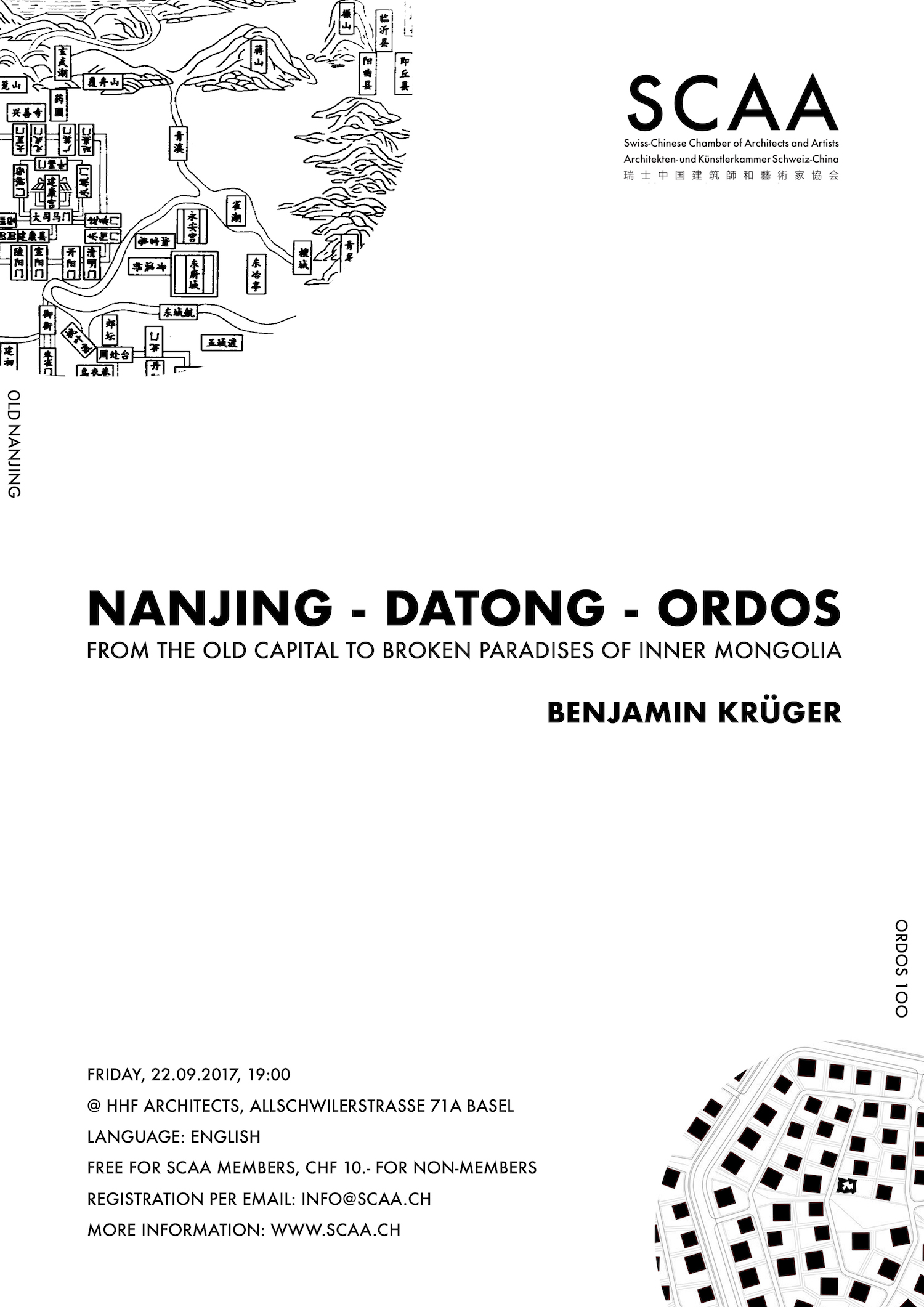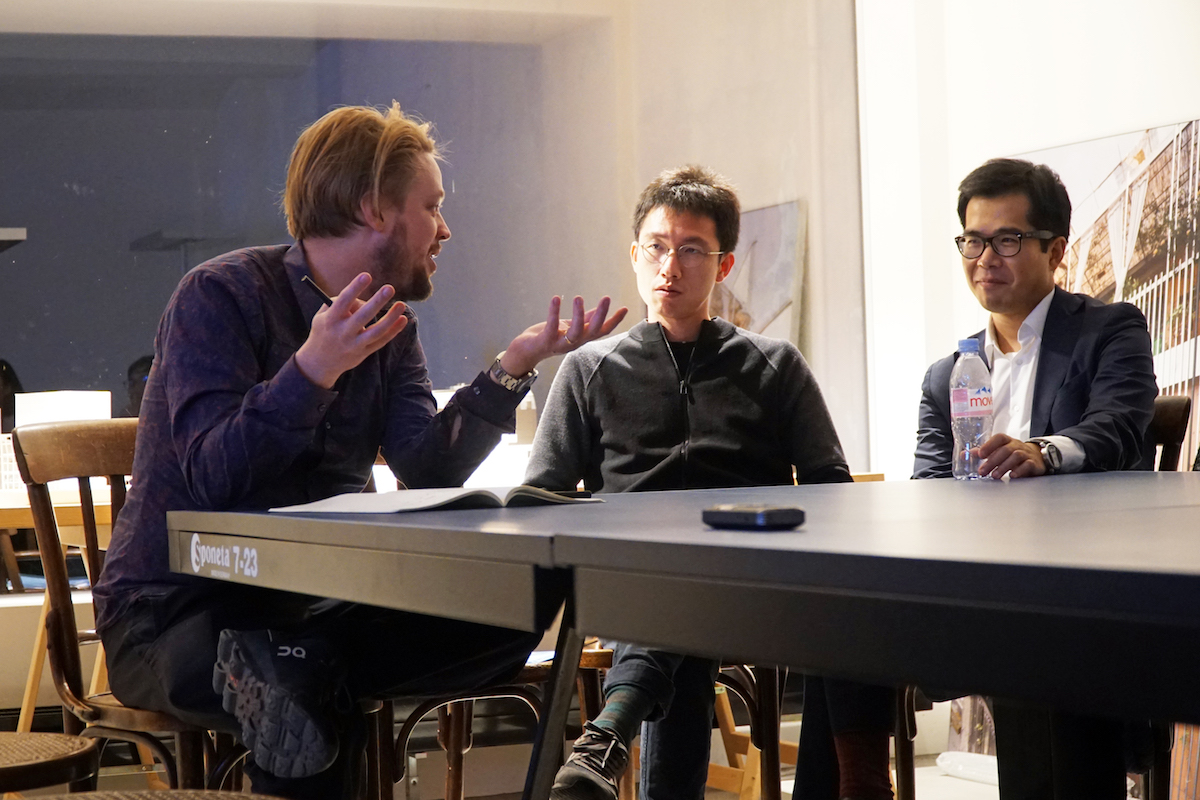[Sep.2017] NANJING – DATONG – ORDOS (From the old capital to broken paradises of Inner Mongolia) 南京 – 大同 – 鄂尔多斯 (从旧都到内蒙古破碎的天堂)

NANJING – DATONG – ORDOS
(From the old capital tobroken paradises of Inner Mongolia)
南京,大同,鄂尔多斯 – 从古都到内蒙古破碎的天堂
SCAA系列讲座 I SCAA主办 I 巴塞尔 2017
主持人:Nils Havelka
中文报道:杨晴川
英文报道:江天
摄影:梁睿哲


For the first time the SCAA held an event outside of Zurich. Benjamin Krüger, associate at HHF Architects, invited the SCAA to apresentation at his office in Basel – a studio in a former ice-cream factory.
这是SCAA第一次在苏黎世以外的城市举办讲座, HHF建筑师事务所的合伙人Benjamin Krüger邀请我们来到建筑师事务所,这里曾经是一个雪糕工厂。在讲座开始前,Benjamin简单带我们参观了HHF事务所以及事务所最近进行的各个项目。
Benjamin studied architecture at the Bauhaus University Weimar, at the Lund University and worked for Swiss architects Herzog & de Meuron. He was a lecturer at the Bauhaus University in Weimar and has been invited as a critic to universities worldwide: the Chinese University of Hong Kong, the University of Hong Kong, ETH Zürich, the University of Bangkok, Politecnico Turino. Thanks to a strong passion and good eye for images Benjamin’s photographical work ‘Finds’ has been exhibited in galleries and a book about his work was published by Lisbon based art book publisher Le Fou. Other works have been released by Planphase magazine and the Cartha platform.
Benjamin gained experience in working with Chinese students during his time as a visiting lecturer at the Southeast University of Nanjing. A search for the Genius Loci – the spirit of the place – was the main topic for Benjamin‘s teaching.
Benjamin Krueger曾在魏玛包豪斯大学及Lund大学学习,在瑞士建筑师事务所赫尔佐格德梅隆工作。他曾被多所大学邀请作为评图嘉宾,包括香港中文大学、香港大学、苏黎世工大、曼谷大学及都灵理工,并在德国魏玛包豪斯大学授课。他的摄影作品“FINDS”曾在Magaz-1画廊及C.Keller画廊展出。作品被位于里斯本的艺术出版社LE FOU出版,更多其它的工作也在PLANPHASE杂志及CARTHA报道。
Benjamin与我们分享了他在东南大学与学生一起工作时的心得体会,对Genius Loci(场所精神)的追寻是他执教的主题。
During the presentation in Basel Benjamin took the SCAA audience on a personal photographic tour to three Chinese cities.
Benjamin在演讲中与我们分享了他所经历的三座城市,通过摄影,给SCAA的成员们展示了他眼中的南京、大同及鄂尔多斯。


For Nanjing, an eight million people city with a remarkably hilly topography, Benjamin and his students were seeking the Genius Loci. What made this place, that had been China’s capital and later non-capital, special for itself? It could not be the high-rise building structures, that looked like built from a generic catalogue. Together with the dean of the university, Bao Li, Benjamin discussed the book on Strollology by Swiss sociologist Lucius Burckhardt. They used Burckhardt’s science of “aimless strolling” to get ahold of Nanjing. After walks with students through various city areas they eventually decided to do a “placemaking” for Jiangxin, a green island in the Yangtze river.The students were to come up with a counter design for what was the reality on the island.
对于南京,这座有着八百万人口的山地城市,Benjamin和学生一起走上街头,寻找Genius Loci。是什么让这座城市,曾经的六朝古都及此后的非首都,与其它城市与众不同?通过摄影师的镜头,放眼望去满是与别处无异的高楼大厦,如今他们充斥在城市的许多角落,但它一定不是这座城市的独特精神。Benjamin与东南大学建筑系系主任鲍莉一起,和学生们讨论了瑞士社会学家Lucius Burckhardt的作品Strollology(散步学)。他们用Burckhardt所说的“无目的的漫游”行走南京,最终决定在江心洲上实践“地点营造”。这个美丽的小岛位于长江上,但现状是岛屿的自然生态已被推土机推平,取而代之的是横平竖直的路网。学生的设计任务便是做一个基于场所真实特点的设计,针对岛屿曾经的真实状况。
1’300 kilometers away from Nanjing lies Datong. Benjamin approached the city progressively from outercircle towards the center. The caves with carved Buddha statues in the Northand the Hanging Temples in the South gave the impression of a very specialspirit. Yet the city center was a contrast to those cultural places. Historicizing architecture for tourists, shopping malls and even a “new” city wall had been constructed in downtown Datong. The flat soil of demolished old town areas was lying right next to the newly built fake realities. Benjamin had the feeling that Datong was pretending to be bigger than it actually was, which resulted in oversized architectural objects. A new museum by David Chipperfield, a theatre by Arata Isozaki and a huge stadium set in the Sports Park were left unfinished and abandoned.
与南京相距1300公里处便是大同。Benjamin从大同的外围逐渐走向城市中心。在行走的过程中,云冈石窟及南面的悬空寺给他非常强烈的印象,然而城市中心却是截然不同于上述地点的另一番景象:众多为游客准备的崭新的仿古建筑、购物中心及一个新的“古城墙”。已被拆迁并夷为平地的旧城区就位于新建的虚假现实世界旁边。Benjamin觉得大同似乎希望自己变得比现实更大,所以导致了市中心的众多超越城市尺度的超大建筑:DavidChipperfield的新博物馆、矶崎新的剧院以及尚未完工便已经被遗弃的体育场馆。


Located in Inner Mongolia, Ordos was a very peculiar place Benjamin presented. Similar to Datong and Nanjing the landscape around it was promising but the city center with its big buildings appeared hard to provide a Genius Loci. Ordos was a city built from scratch. It had been planned for eight to nine million inhabitants. The reality was a population of 100’000, of which most people were doing facility management on the left building structures. Back in 2008 artist and architect Ai Wei Wei had teamed up with Herzog & de Meuron for a masterplan called Ordos 100. One hundred architects from 27 countries had been asked to submit designs for one hundred large villas in Ordos. HHF was one of the architecture offices taking part and, like for most of them, the designed villa was left unfinished until today – in a kind of ghost town.
位于内蒙古中部的鄂尔多斯在Benjamin眼里是一个非常特别的地方。与南京及大同相似,鄂尔多斯及其周边的景观都十分具有吸引力,但城市中心却充斥着巨大的难以反映地点特性的构筑物。鄂尔多斯是一座从零开始建造的城市,设计规划八到九百万人口。但现实却是十多万人口,其中大多还是已建建筑和设施的维护人员。早在2008年艾未未与赫尔佐格一起,发起了“鄂尔多斯100”的规划,邀请来自27个国家的100位建筑师在鄂尔多斯设计100栋小房子。HHF建筑事务所便是其中之一,但与大多数事务所一样,设计的别墅到今天也未完工,整个城区像座鬼城。



With the three presented examples Benjamin showed how challenging the quest for a Genius Loci could be in Chinese cities. The scale and also pace of the urban developments generated endless difficulties and possibilities at the same time. One possibility for Nanjing’s Jiangxin island was portrayed by a student group of Benjamin’s. The project called Traces was based on a thorough analysis of the island’s past and present geography. The students came up witha solution that integrated the use of the Yangtze river and brought local life onto the island through an intelligent combination of building and landscape architecture. These students did find the spirit running right through Nanjing.
Benjamin经历的三座城市,让他觉得在中国追寻和展示Genius Loci(场所精神)是多么的困难,但城市发展的巨大规模及速度在带来无穷挑战的同时也带来了巨大的可能性。在南京江心洲的教学活动中,Benjamin指导的一个作业便尝试了一个能体现场所精神的可能性。这个名为“痕迹”的作品分析了岛屿过去和现在的地形。学生通过巧妙的建筑与景观设置,将当地日常生活和长江的利用结合起来,实现了综合利用长江的解决方案。




More photos on SCAA Facebook: https://www.facebook.com/media/set/?set=a.472298563139065.1073741835.400289230339999&type=1&l=87d1718abe

